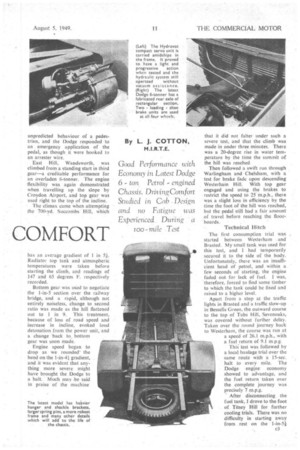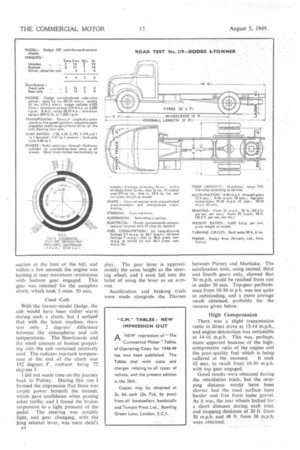Technical Hitch
Page 39

Page 40

If you've noticed an error in this article please click here to report it so we can fix it.
The first consumption trial was , started between Westerham and Brasted. My small tank was used for this test, and 1 had temporarily secured it to the side of the body. Unfortunately, theie was an insufficient head of petrol, and within a few seconds of starting, the engine faded out for lack of fuel. 1 was, 'therefore, forced to find some timber to which the tank could be fixed and raised to a higher level.
Apart from a stop at the traffic lights in Brasted and a traffic slow-up in•Bessells Green, the outward course to the top of Tubs Hill, Sevenoaks, was covered without further delay. Taken over the round journey back to Westerham, the course was run at a speed of 26A m.p.h., with a fuel return of 9.1 m.p.g.
This test was followed by a local haulage trial over the same route with a 15-sec. halt to • every mile. The Dodge engine economy showed to advantage, and the fuel return taken over the complete journey was precisely 7 m.p.g. .
After disconnecting the fuel tank, I drove to the foot of Titsey Hill for further cooling trials. There was no difficulty in starting away from rest on the 1-in-5i section at the foot of the hill, and within a few seconds the engine was turning at near maximum revolutions with bottom gear engaged. This gear was .retained for the complete climb, which took 5 mins. 50 secs.
With the former-model Dodge. the cab would have been rather warm during such a climb, but I noticed that with the latest machine there was only 2 degrees' difference between the atmospheric and cab temperatures. The floorboards and the small amount of bonnet project
mit the cab -remained relatively cool. The radiator top-tank temperature at the end of the climb was 192 degrees F., ambient being 72 degrees F.
I did not waste time on the journey back to Putney. During this run I formed the impression that there was ample power beneath the bonnet, which gave confidence when passing other traffic, and I found the brakes responsive to a light pressure of the pedal The steering was notably light, and gear changing, with the long selector lever, was mere ebikl's c4 play. The gear lever is approxi mately the same height as the steering wheel, and I soon fell into the habit of using the lever as an armrest.
Acceleration and braking trials were made alongside the Thames between Putney and Mortlake. The acceleration tests, using second, third and fourth gears only, showed that 30 m.p.h. could be reached from rest in under 30 secs. Top-gear performance from 10-30 ni p h. was not quite so outstanding, and a more average result obtained, probably for the reasons given below.
High Compression There was a slight transmission rattle in direct drive at 1244 m.p.h., and engine detonation was noticeable at 14-16 m.p.h. This was, perhaps, more apparent because of the highcompression ratio of the engine and the poor-quality fuel which is being suffered at the moment. It took 42 secs. to reach from 10-30 m.p.h. with top gear engaged.
Good results were obtained during the retardation trials, but the stopping distance would have been shorter had the road surface been harder and free from look gravel. As it was, the rear wheels locked for a short distance, during each trial, and stopping distances of 20 ft. front 20 m.p.h. and 48 ft. from 30 m.p.h. ' were obtained.
























































































